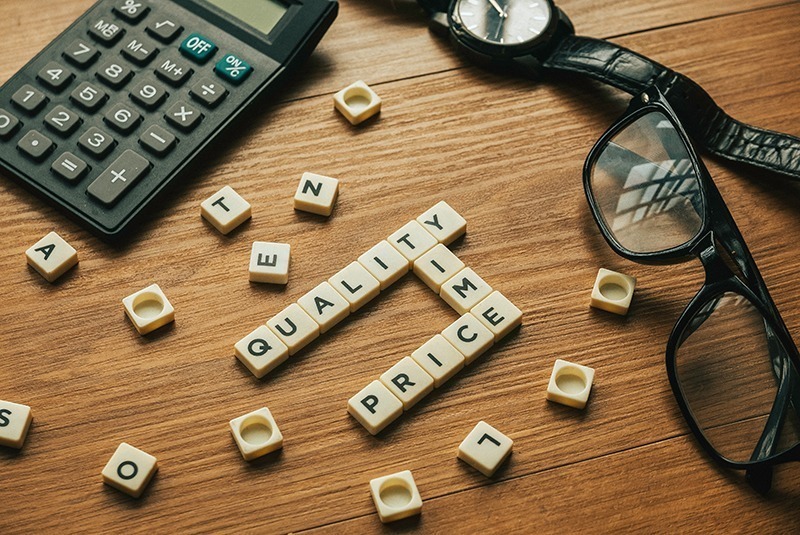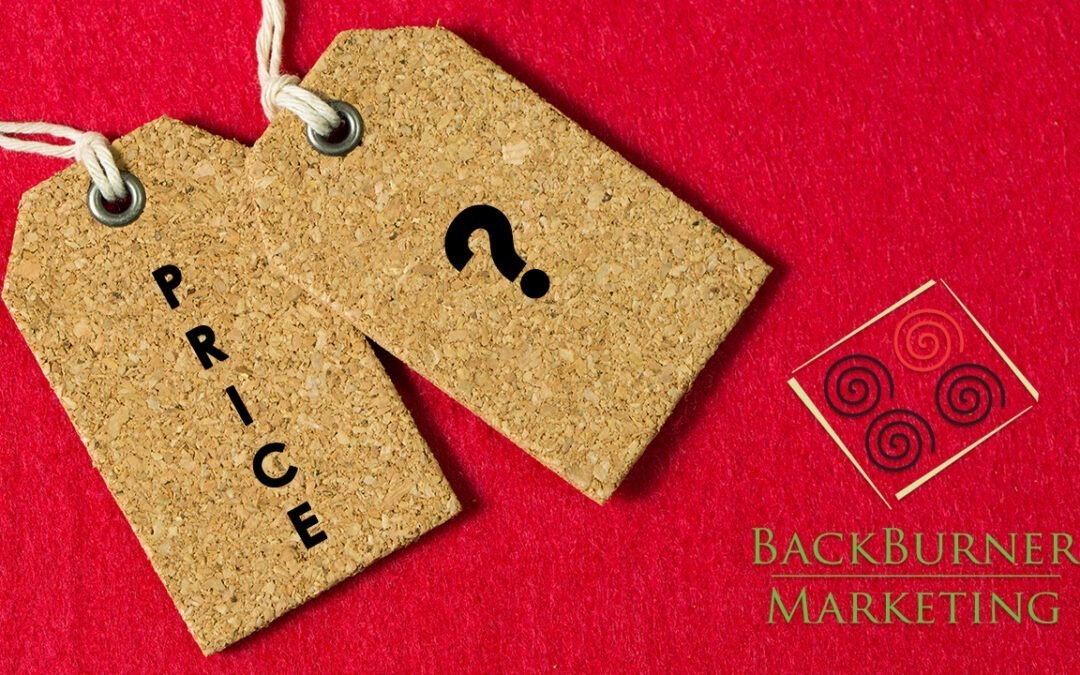How should you price products or services?
As a business coach, I work with lots of companies and individuals at various stages of business and product development. Routinely, one of the bigger problems I run into—and not just with new business owners-is establishing a price structure.
At the end of the school year, my son and two friends started a pressure washing business. They did all the work of starting the business themselves, buying machinery and chemicals, setting up a system that worked well, defined roles and expectations. But they hit a wall when it came to pricing.

Do we just Google what other people charge?
“Do we just Google what other people charge? Or just toss a high number out there and negotiate down to what the customer is willing to spend?” This is a typical small business problem. I offered to trade a consult for a pressure-washed driveway.
There are countless philosophies, methodologies, formulas, and calculators available online geared to help put logical, marketable numbers after the dollar sign on the price tag. Often, they turn out to be only marginally helpful, mainly because business owners don’t understand the concepts behind pricing, and they are left wondering how to price products or services.
It’s not that hard. Really. I will walk you through a straightforward approach to this method and point out where you need to be mindful of potential dangers or give some additional thought to the peripheral—but important—factors.
Let’s say you’re a tech wizard who built a better mousetrap. Or robot, actually. Mousetraps are boring. Robots are sexy. Let’s say your robot vacuums the floor, does the dishes, and walks the dog. So you’re newfangled robot has the same functions as my teenage son, except that it actually does the dishes, walks the dog, and vacuums the floor. How do you price this modern marvel?
One way would be to find the price of the average teenage boy and put that on the price tag. This is hardly scientific, and probably illegal in most countries.
So that anecdotal method: no good.
Should we compare to competitors to price products or services?
Another way is to look at what the other robot companies are charging. You Google robots with the same functions and find that Dave’s Robots cost $499. It also came up first in the Google search, so it must be a good product, right? (No! But that’s a topic for another blog.)
Another robot that turned up in the search is ReplaceATeen, which is slightly cheaper at $475 but still offers the same features. But it’s a lot slower than the Dave’s Robots model. Both are about equal in size to the one you make, and have more or less the same shape. ReplaceATeen has a better gripper so it opens doors more easily.
Your robot is faster than both, comes with two grippers that can actually play the ukulele, and is made right here in the good ol’ USA. So, is that enough to go on? How do you price your new product?
Here’s the thought process that many of our clients follow when they price products or services:
Your robot is a better performer—it’s faster, and offers features that blow the competition away. I mean, the ukulele…deal closed it right there, right? So, price it at $850. Simple. Done.
But wait. Here’s a thought. Your robot is new in the marketplace, as is your company. Nobody knows who you are. Those other robots have been around for a few years. Nobody is going to spend the same amount of money much less more on a brand new product. Better price it at $325. Yeah, that’s safe. Who wouldn’t pay that little bit for all that robot?

Then it strikes you that if Dave’s Robots are selling at 500 and ReplaceATeen is selling at $475, Wouldn’t it follow that you’re robot should also be in that range? After all, these are established companies. They must surely have done lots of market research and found out that that’s exactly the right price. That $400 figure must be what the market will bear, so that’s how much your robot should cost, too. Let’s split the difference. $385. Cool! Let’s whip up those Facebook ads and get them in for everyone to see.
There must be a better way!
Not so fast! There must be a better, more scientific way to determine pricing. Well, there is. Sort of.
Like so many things in the world of marketing, there are no absolutes. Pricing is another mix of art and science, where we combine research and gut feeling to come up with an answer that works.
There is a generally accepted calculation, or at least a process, that many product marketing people use to price products or services. We will discuss that. But it has to be noted that it will only offer a starting point. Some of the thoughts discussed in the examples above are actually valid and do not fall into the calculation that we will examine. This is where the art comes in. Just what is the real street value of novelty, new features, faster speed? We will discuss that, as well.
You can, of course, charge less, but then we get into a different sort of problem I have addressed in a blog or two on creative services. Designers and writers are notorious under-chargers.
Obviously, experience helps. But even experienced workers, consultants, or any kind of expert needs to do research. Find out what the local economy expects. The old adage that you sell at the price the market will bear is certainly true, but there are pitfalls. What the market will bear may not be enough for you to generate a profit. That is, as we say in the marketing business, bad.
The broad questions in the pricing game are what are you selling, who will buy it, and what does the competition charge for it?
It’s not impossible that you can price products or services objectively high and, by sheer luck, find clients who are willing to pay it immediately. Good fortune right out of the gate does not necessarily guarantee long-term success.

Fundamental to pricing is cost.
If you don’t know your cost you cannot price sensibly. The classic target markup for products is 50%, but there are variations by industry. When I worked in a bookstore in college, the average markup of a hard cover book was 40%. Sneakers are marked up at least 100%. Pharmaceuticals have a 300 to 3000% mark up. Candy and popcorn and a movie theater… There are no numbers to express that markup.
There are also indirect costs. This is often called overhead. This is generally rent, utilities, cost of non-product related labor, such as executor or accounting salaries.
Direct costs are easy to work into your pricing structure. To include the indirect costs, you have to make an assumption on how many units will be sold and divide the indirect costs by that number. There is an amount of speculation involved here, obviously.
Direct costs plus a portion of indirect costs gives you what each unit will cost. You can then tack on 50% profit and that would be your final price. This method is called cost-plus pricing. You can stop here, but you may be leaving some money on the table.
Now that you have an idea of the classic cost-plus calculation for pricing, let’s look at how features of your product or service might make a difference in your final price. What makes you different? How much will those differences (or value differentiators) add or subtract from the final price you can hope to claim in the marketplace? Can you turn those differences into value statements that address the benefits of your product or service to its target market? If so, then value-based pricing is a better way to determine your pricing structure.
Your product, with its world-beating additional feature, still could be priced lower, equal to, or higher than the competition. A clearly better product that’s cheaper than the competitors’ version could gain a lot of traction in the marketplace. It could also start a price war. Or it could reset the price that the market will bear. Why buy Dave’s Robots for more money when NewBot is cheaper and better?
Depending on just how valuable the market perceives differentiators of your product to be compared to others, your price can be considerably different from the competitors. Do some research, even if it is simply asking current owners of competitors’ products what they like and dislike about them. Don’t forget to speak with people who do not have the product. Ask why. Do they not want it? Do they want it but have not bought it? Again, why? If you find that current products are seen as too expensive, too slow, too hard to maintain or fix, then you have some valuable intel on which to base your pricing model.
Value-based pricing might seem a little less scientific. It is. It involves a little bit of intuition, research, and sometimes guesswork, but it results in a better final price because it takes into account more than simply cost.
In a perfect world, the additional features of your product will make it even more appealing to the marketplace than current products.
So, what do you do with that knowledge?
A higher price is a no-brainer. Better product, higher price. If the market research tells you that people will buy at that price then that might be the way to go. But will you be able to sell enough units to turn the kind of profit you want? If you can sell 500,000 units at $500 but only 1000 at $850 then your higher per item price isn’t helping you much.

In any market, there are tiers of clients who expect to pay a certain amount for services. The largest group, typically, is in the middle of the road. On either side of them are the bargain hunters (or, as my wife somewhat affectionately calls me, cheapskates) and those with more disposable income. Rich people, my son calls them, and they comprise the primary target market for his fledgling pressure washer business.
Fortunately, they are the low hanging fruit in his business, and he has been able to pick them easily. But how long will that work with any product or service? The answer depends on the product, the place, the economy, the competition, what time of year, and any number of secondary factors.
Pricing is part art, part science. Get it right and your business might take off. Get it wrong and you will be fighting for the scraps left over at the top and the bottom of the marketplace.

